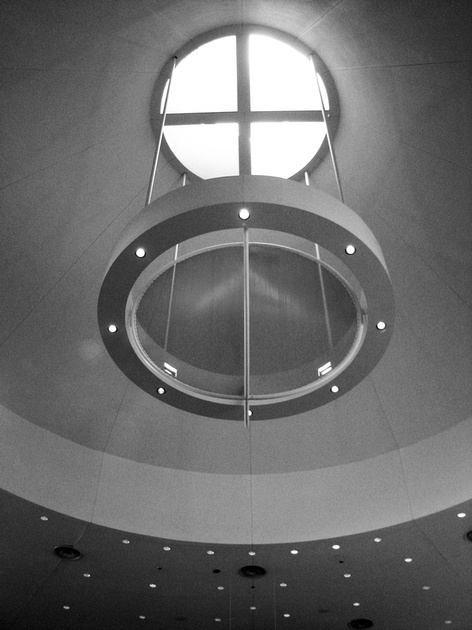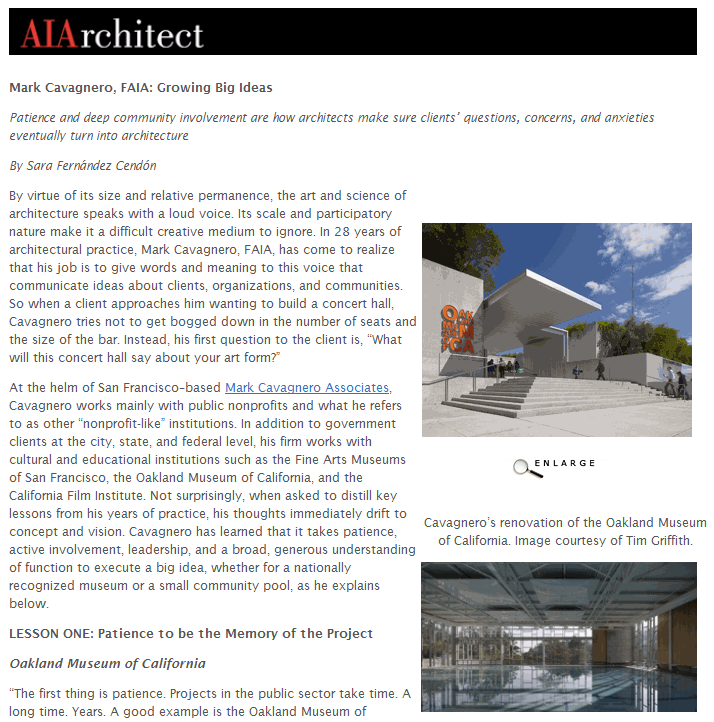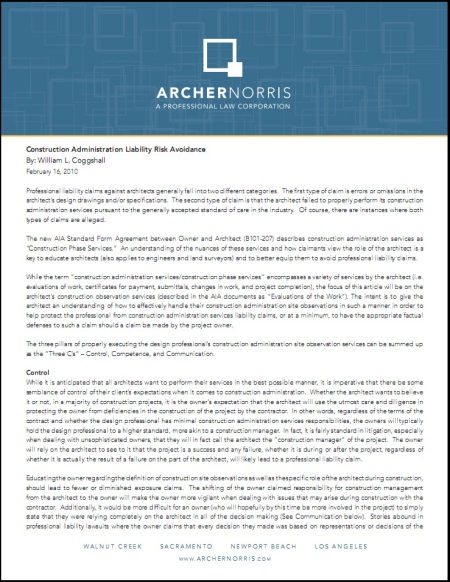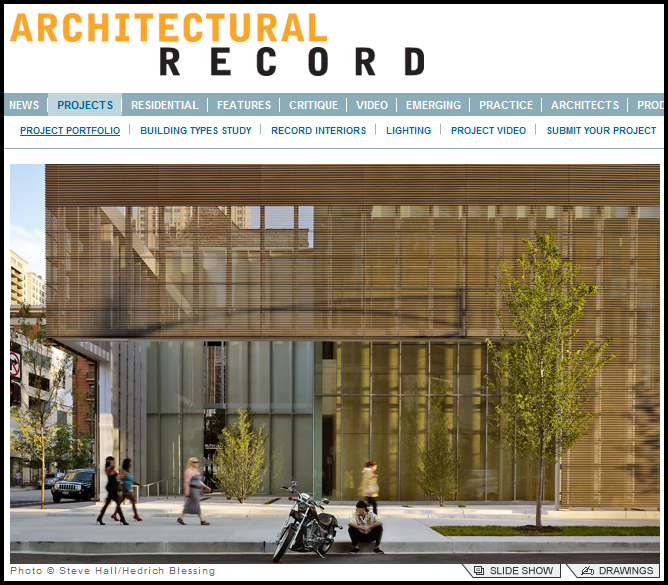Congratulations to a/e ProNet client Dreyfuss & Blackford Architects for their 2013 Firm Award from the AIACC!
Tag: AIA
 Attention, Architecture students! We know how hard you’re working toward your dream career, and we also know the cost of your education is high. Have you applied for the David W. Lakamp AIA Scholarship?
Attention, Architecture students! We know how hard you’re working toward your dream career, and we also know the cost of your education is high. Have you applied for the David W. Lakamp AIA Scholarship?
The David W. Lakamp AIA Scholarship was established in 1990 by a/e ProNet, a group of insurance professionals providing risk management services to architects and engineers. It was renamed in 1999 for David W. Lakamp, one of our founding members, and a widely-trusted advisor to the design industry. Mr. Lakamp left behind a legacy of professionalism and integrity that set new standards in the field of insurance services.
Today, the scholarship provides two $2,500 awards each year, and these are bestowed upon the two students who best demonstrate strong interest in practice management.
The scholarship is open to fourth-year undergraduates and graduate students of architecture enrolled in an NAAB-accredited professional degree program. Submissions are reviewed by a jury panel consisting of members of the AIA Practice Management Knowledge Community (PMKC) and the a/e ProNet organization. Candidates must submit a copy of their transcripts, two letters of recommendation, and an essay on how they would resolve a project management dilemma.
The current application deadline is November 19, 2012.
Visit the education section of the AIA website for more information, as well as to download a PDF of the 2012 a/e ProNet David W. Lakamp AIA Scholarship application.
In 2011, two recipients were awarded the a/e ProNet David W. Lakamp Scholarship. To read their case study topic responses, please click here.
Questions? Please send inquiries to: scholarships@aia.org
 Risk Allocation is an important part of the contract negotiation process for Architects, Engineers, and other Design Consultants.
Risk Allocation is an important part of the contract negotiation process for Architects, Engineers, and other Design Consultants.
“In allocating risks by contract terms and conditions, the goal is to allocate the specific risks to the party with the best ability to manage them. Although a contract can assign ownership of risks to any party, there can be serious adverse consequences if a party assumes risks it can’t manage. A design firm, for example, isn’t in a position to manage site safety responsibilities that most appropriately belong to the construction contractor. Despite the practicalities, however, of who is actually in the best position to manage site safety, if the design firm agrees to such responsibility by contract, the designer may be found liable for site safety by courts and possibly the Department of Labor.
“To be reasonable, a contract must be reasonable for all parties involved. If a contract attempts to shift all the risks to one party or the other, it will create problems on the project. A one-sided contract is likely to cause hard feelings during contract administration. It may also increase the likelihood of claims turning into litigation. As a practical matter, this means parties are better served by negotiators who don’t try to negotiate a contract that unreasonably shifts risk to someone who can’t logically manage it or accept legal responsibility for it. Such risk transfer will cause problems in the long run, and may even create uninsurable losses and claims.
“In evaluating who the various risks should be assigned to, parties can develop a table or list of responsibilities and risks to more easily see which risks most logically belong to each party. For example, site safety typically falls to the construction contractor. Easements and rights-of-way, as well as site data, including geotechnical information, may logically be allocated to the project owner. Responsibility for exercising due care in the planning and designing of a project generally falls to the design professional performing those services.
“Problems begin when any of these risks are allocated to the party that is not technically responsible for the related services. Unless you are in a position to manage a particular risk, it is not appropriate for you to accept contractual liability for that risk.”
This is an excerpt from a/e ProNet’s Risk Management & Contract Review Guide for Design Professionals (© Copyright 2006; a/e ProNet & J. Kent Holland, Jr.), one of the many resources ProNet Member Broker’s provide to their clients. A digital version of the full guide is available for purchase ($19.99). Contact a/e ProNet today to get in touch with your local ProNet broker.
About the Author: J. Kent Holland is a construction lawyer located in Tysons Corner, Virginia, (formerly with Wickwire Gavin, P.C. and now with Construction Risk Counsel, PLLC) representing design professionals, contractors and project owners. He is founder and president of a consulting firm, ConstructionRisk, LLC. He is also the author of Contract Concerns, a series of articles available on our website here.
a/e ProNet has been an advocate for architects, engineers, and other design consultants for more than 20 years. This advocacy includes an abiding interest in protecting the integrity and sanctity of the products delivered by design professionals. We’re proud of what our clients can do and have done to better and beautify communities across the globe.
Taking that pride one step further, we’ve created a Pinterest board dedicated to showcasing the fantastic designs of our ProNet Members’ clients!
Buildings, bridge, amphitheaters, parks, homes, aqueducts, highways, theme parks, wineries, storefronts, and resorts surround and inspire us daily. But as Peter W. Jones, AIA, President of AIA Florida recently reminded us, “Behind every magnificent structure is an architect who helped create it.” In fact, behind every magnificent structure is a team of imaginative, experienced professionals who worked together to meet that goal. And we’re proud to say that many of those professionals are the clients of our members.
If you love design, follow our Pinterest board today!
Longtime design industry advocate, a/e ProNet, announced this week that ProNet President Leslie Pancoast will make a presentation at EDSYMPOSIUM12, the 42nd annual education conference hosted by the Society for Design Administration (SDA), an affiliate of The American Institute of Architects.
For more than 50 years, the SDA has promoted education and best practices for design firm administrative personnel. EDSYMPOSIUM12 will take place from May 2-5 at the Embassy Suites Hotel in Portland, Oregon. a/e ProNet will sponsor Saturday’s luncheon, where Pancoast will make a two-fold presentation: Introduction to a/e ProNet and Professional Liability—Coverages, Nuances and Endorsements. SDA members will learn more about a/e ProNet and its active support for the design industry, as well as receive a brief overview of professional liability coverage and the standard endorsements available from most professional liability insurance providers for architects and engineers.
About Leslie Pancoast
 Pancoast has specialized in the insurance needs of architects, engineers and other design consultants for more than 20 years. She is a Managing Partner of Insurance Office of America (IOA), one of the largest privately-held insurance agencies in the country. She is also the Branch Manager of IOA’s San Francisco Bay Area office, operating in California as IOA Insurance Services, which she opened in 2005. Pancoast has earned the designations of Commercial Insurance Counselor (CIC) and Registered Professional Liability Underwriter (RPLU). She has been an active board member of a/e ProNet since 2005, and currently serves as the membership’s President.
Pancoast has specialized in the insurance needs of architects, engineers and other design consultants for more than 20 years. She is a Managing Partner of Insurance Office of America (IOA), one of the largest privately-held insurance agencies in the country. She is also the Branch Manager of IOA’s San Francisco Bay Area office, operating in California as IOA Insurance Services, which she opened in 2005. Pancoast has earned the designations of Commercial Insurance Counselor (CIC) and Registered Professional Liability Underwriter (RPLU). She has been an active board member of a/e ProNet since 2005, and currently serves as the membership’s President.
About a/e ProNet
Established in 1988, a/e ProNet is a national network of specialist brokers. The group focuses on providing educational resources and risk management services to its members’ clients. Its member brokers represent a combined annual professional liability premium volume exceeding $300 million, giving top-tier insurance companies a major incentive to work closely with a/e ProNet to enhance their various a/e programs.
As well, a/e ProNet makes a wide range of Risk Management resources available to all design professionals via their website, including ProNet Practice Notes, Guest Essays, ProNetwork News, Contract Concerns, Typical Coverages, and Frequently Asked Questions.
a/e ProNet is excited about the opportunity to partner with the SDA in order to provide this value-added educational resource to design firm administrative personnel across the country.
Additional information is available about a/e ProNet by visiting their website, following them on Twitter, and/or Liking their Facebook page.
 The AIA recently published a profile of a/e ProNet client Mark Cavagnero Associates of San Francisco, CA. This year alone, this highly acclaimed firm has received the AIA California Council Firm Award, the Contract Interiors Award for Historic Restoration (UC Berkeley Durant Hall), and the IIDA Northern California Chapter Merit Award (East Bay Center for the Performing Arts). A full list of Cavagneros projects, clients, and awards can be found here.
The AIA recently published a profile of a/e ProNet client Mark Cavagnero Associates of San Francisco, CA. This year alone, this highly acclaimed firm has received the AIA California Council Firm Award, the Contract Interiors Award for Historic Restoration (UC Berkeley Durant Hall), and the IIDA Northern California Chapter Merit Award (East Bay Center for the Performing Arts). A full list of Cavagneros projects, clients, and awards can be found here.
The following is an excerpt of the AIA article entitled Mark Cavagnero, FAIA: Growing Big Ideas:
In 28 years of architectural practice, Mark Cavagnero, FAIA, has come to realize that his job is to give words and meaning to this voice that communicate ideas about clients, organizations, and communities… Cavagnero works mainly with public nonprofits and what he refers to as other “nonprofit-like” institutions. In addition to government clients at the city, state, and federal level, his firm works with cultural and educational institutions such as the Fine Arts Museums of San Francisco, the Oakland Museum of California, and the California Film Institute. Not surprisingly, when asked to distill key lessons from his years of practice, his thoughts immediately drift to concept and vision. Cavagnero has learned that it takes patience, active involvement, leadership, and a broad, generous understanding of function to execute a big idea, whether for a nationally recognized museum or a small community pool.
According to the company bio, “Mark Cavagnero Associates’ design process begins with a careful investigation of the client’s goals and the project site… The firm welcomes the constraints of program, site, and budget as frameworks within which to create engaging architectural spaces. It is in the focused response to these project elements that the essential character of each project finds its voice. The purity of response—in form, material, and relationship to light and context—is always the firm’s goal.” To read more about Mark Cavagnero Associates, visit the firm’s website.
We applaud this recognition of Cavagnero as an architect who champions the broader ideals of his field, and we urge everyone to read the full profile here.
 So, your architecture firm is preparing to sign a contract on a new project. You’ve reviewed the wording with your insurance broker and attorney. You feel good about the language, the limitation of liability, and the scope of services outlined therein. (And you feel even better about the fees you’ll be collecting along the way!) But before you scribble your name on the dotted line, it is important to remember that the black and white words in the contract only go so far.
So, your architecture firm is preparing to sign a contract on a new project. You’ve reviewed the wording with your insurance broker and attorney. You feel good about the language, the limitation of liability, and the scope of services outlined therein. (And you feel even better about the fees you’ll be collecting along the way!) But before you scribble your name on the dotted line, it is important to remember that the black and white words in the contract only go so far.
The signed contract is only the first (if the most major) verifiable communication between the interested parties: Architect and Owner. As the project progresses, you’ll be communicating with the owner many more times, not only for changes and modifications to the design, but depending on the scope of your responsibility when you visit the job site, you may be keeping the owner apprised of progress. More importantly, you may be alerting the owner to problems!
Stepping outside your scope when it comes to construction administration is a risk and may leave your firm vulnerable to claims. Likewise, dealing directly with contractors without remembering your relationship to the owner (“the law will treat the architect as the owner’s agent”) is also risky. In his newsletter titled Construction Administration Liability Risk Avoidance, William L. Coggshall of Archer Norris covers some of the steps an architect can take to manage these risks.
The following is an excerpt of the aforementioned newsletter published in February of 2010. For access to the full-length PDF version of this newsletter, please visit our website.
Professional liability claims against architects generally fall into two different categories. The first type of claim is errors or omissions in the architect’s design drawings and/or specifications. The second type of claim is that the architect failed to properly perform its construction administration services pursuant to the generally accepted standard of care in the industry. Of course, there are instances where both types of claims are alleged.
The new AIA Standard Form Agreement between Owner and Architect (B101-207) describes construction administration services as ‘Construction Phase Services.’ An understanding of the nuances of these services and how claimants view the role of the architect is a key to educate architects (also applies to engineers and land surveyors) and to better equip them to avoid professional liability claims.
While the term ‘construction administration services/construction phase services’ encompasses a variety of services by the architect (i.e. evaluations of work, certificates for payment, submittals, changes in work, and project completion), the focus of this article will be on the architect’s construction observation services (described in the AIA documents as ‘Evaluations of the Work’). The intent is to give the architect an understanding of how to effectively handle their construction administration site observations in such a manner in order to help protect the professional from construction administration services liability claims, or at a minimum, to have the appropriate factual defenses to such a claim should a claim be made by the project owner.
The three pillars of properly executing the design professional’s construction administration site observation services can be summed up as the ‘Three C’s’ – Control, Competence, and Communication.
Access the full-length PDF version of the newsletter here.
About the Author: William L. Coggshall is a litigator with the Archer Norris professional liability and construction practice groups, specializing in the representation of architects and engineers in complex commercial litigation. The lawyers in our Design Professionals Liability practice group provide advice and litigation support to architects, engineers and other design professionals.
Newsletter provided by a/e ProNet Member Melissa Roberts of Euclid Insurance Agencies.
This article is intended to provide Archer Norris clients and contacts with general information. The content of this publication is for informational purposes only. Neither this publication nor its authors are rendering legal or other professional advice or opinions on specific facts or matters. No attorney-client relationship is created by this advisory, nor by any response to the information herein, unless and until a conflicts review has been conducted by Archer Norris, and a written agreement containing all terms of representation has been signed. Copyright © 2010, Archer Norris, PLC. All rights reserved. Archer Norris grants its clients and contacts permission to forward this publication to third parties in its entirety and without alteration or modification. You may also reproduce this material for your own personal use and for non-commercial distribution. All copies must include the above copyright notice. Please do not replicate, or post on your website, without our express written permission. Any rights not granted in this disclaimer are expressly reserved. Attorney Advertising. Prior results do not guarantee a similar outcome.
 Since its June 2011 completion, the new Poetry Foundation Headquarters in the River North district of Chicago, designed by a/e ProNet client John Ronan Architects, has turned quite a few heads. First, it received a glowing write-up in the Architectural Record:
Since its June 2011 completion, the new Poetry Foundation Headquarters in the River North district of Chicago, designed by a/e ProNet client John Ronan Architects, has turned quite a few heads. First, it received a glowing write-up in the Architectural Record:
“In keeping with the art form it serves, the new Poetry Foundation is a respectful, restrained building that employs an economy of means and methods, just as a good poem employs an economy of language.”
Then, earlier this month, the graceful, angular building received the Honor Award from the American Institute of Architects. While this could be simply another feather in the hat of the prestigious Chicago architect, John Ronan continues to hold fast to the basic integrity at the foundation of his practice. In a recent interview with the Chicago Tribune, Ronan pointed out, “There’s sort of an ethical imperative when you’re doing public architecture to serve the public and not your own ego. Where do you want to put that money: on geometry, a weird shape, or put it [into interior] spaces?”
The following is an excerpt from the Jan. 15 Chicago Tribune profile of Ronan, a piece entitled Rising star John Ronan has risen:
“Last week was a good one for Ronan. His Poetry Foundation building, an austere but richly layered modernist design at 61 W. Superior St., won a prestigious Honor Award from the American Institute of Architects. And his South Shore International College Prep High School, at 75th Street and Jeffery Boulevard, was splashed across four pages of the January issue of Architectural Record magazine. Meanwhile, he’s leading the search committee for a new architecture school dean at the Illinois Institute of Technology.”
Anyone can see that the client is happy, too. In its official press release regarding the design award, the Poetry Foundation also likened Ronan’s design to a poem:
“Designed by the Chicago firm John Ronan Architects, the building, which includes 22,000 square feet of interior space and a nearly 4,000-square-foot public garden, takes its cues from the art form it represents. Like a poem that invites multiple readings, the space encourages repeat visits, revealing itself slowly over time.”
As in the appraisal of any kind of magic, it is difficult to measure the success of architecture. Certainly, every building has its measurable characteristics: functionality, a publicly pleasing aesthetic, green materials (per the Poetry Foundation HQ press release, the new structure is “built to comply with the US Green Building Council’s Silver Level LEED Rating System”). But beyond that, one must consider the measure of the intangible.
In this case, Ronan’s client believes the new structure accomplishes what Poetry Magazine founder Harriet Monroe’s original vision for her publication was in 1912, “A modest effort to give to poetry her own place.” We congratulate John Ronan Architects for all of these achievements.



